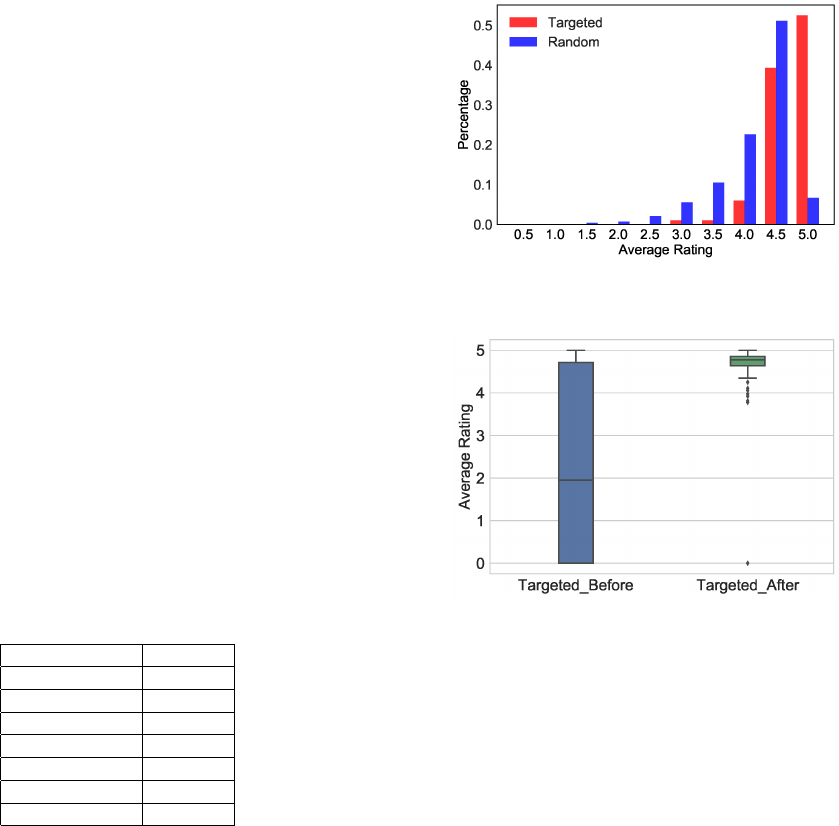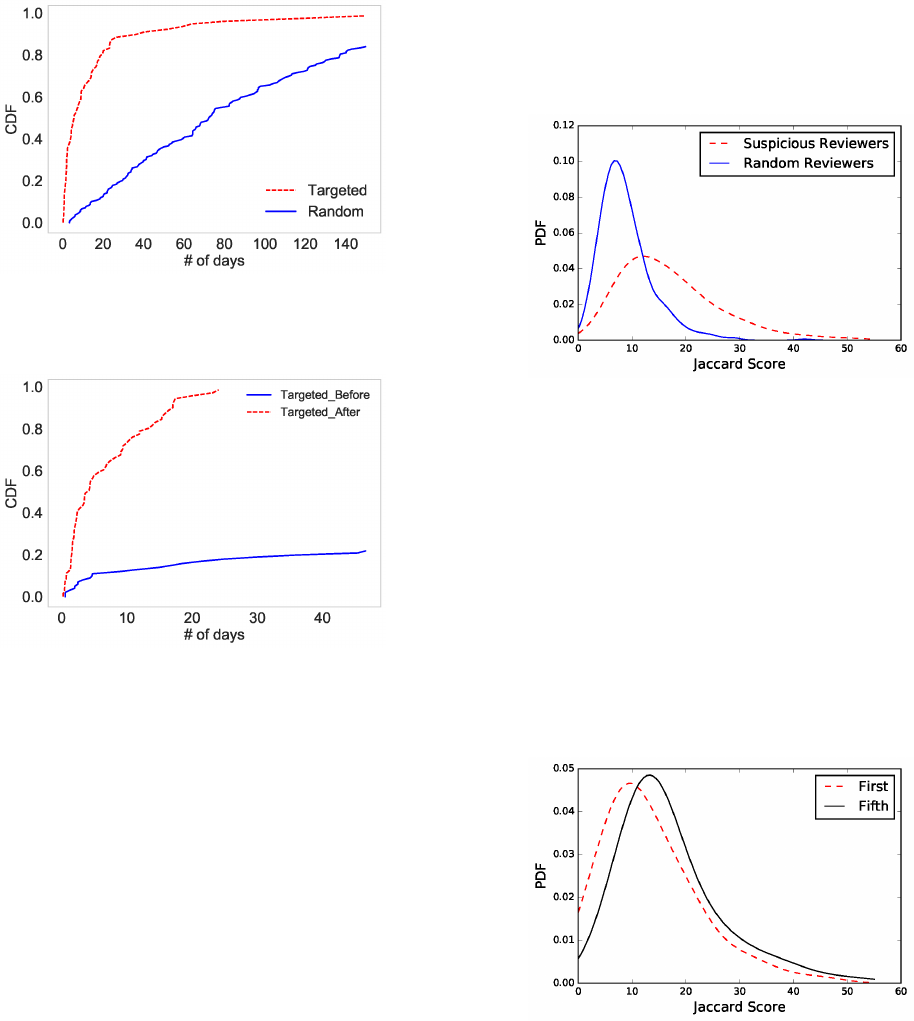
Crowdsourced App Review Manipulation
Shanshan Li James Caverlee Wei Niu Parisa Kaghazgaran
Department of Computer Science and Engineering, Texas A&M University
College Station, Texas, USA
{ssli,caverlee,niu,kaghazgaran}@tamu.edu
ABSTRACT
With the rapid adoption of smartphones worldwide and the reliance
on app marketplaces to discover new apps, these marketplaces are
critical for connecting users with apps. And yet, the user reviews
and ratings on these marketplaces may be strategically targeted by
app developers. We investigate the use of crowdsourcing platforms
to manipulate app reviews. We nd that (i) apps targeted by crowd-
sourcing platforms are rated signicantly higher on average than
other apps; (ii) the reviews themselves arrive in bursts; (iii) app
reviewers tend to repeat themselves by relying on some standard
repeated text; and (iv) apps by the same developer tend to share
a more similar language model: if one app has been targeted, it is
likely that many of the other apps from the same developer have
also been targeted.
KEYWORDS
app reviews; manipulation; crowdsourcing; user behavior
1 INTRODUCTION
Mobile app marketplaces like Google Play and Apple’s App Store
serve as the nexus for many of our online experiences. With the
rapid adoption of smartphones worldwide and the reliance on app
marketplaces to discover new apps, these marketplaces are critical
for connecting users with apps [
5
]. A key factor driving user en-
gagement with apps is user reviews and ratings. Indeed, previous
research has explored text mining to identify ne-grained app fea-
tures mentioned in reviews [
4
] and how user reviews can improve
app retrieval through methods that exploit reviews [
7
,
9
]. From
a software engineering perspective, researchers have developed
methods to extract informative reviews that can help developers
respond to user feedback [
2
] and observed that apps that respond
to user feedback (e.g., via bugs or desired features suggested in user
reviews) in future releases do indeed increase their ratings over
time [2, 8].
And yet, these user reviews and ratings may be strategically
targeted by app developers to articially promote their own apps
(or potentially, to demote the apps of competitors). Indeed, seminal
work by Chandy et al. [
1
] identied spam app reviews which aim
to deceive users to download harmful apps or impede them from
Permission to make digital or hard copies of all or part of this work for personal or
classroom use is granted without fee provided that copies are not made or distributed
for prot or commercial advantage and that copies bear this notice and the full citation
on the rst page. Copyrights for components of this work owned by others than ACM
must be honored. Abstracting with credit is permitted. To copy otherwise, or republish,
to post on servers or to redistribute to lists, requires prior specic permission and/or a
fee. Request permissions from [email protected].
SIGIR ’17, August 07-11, 2017, Shinjuku, Tokyo, Japan
© 2017 ACM. 978-1-4503-5022-8/17/08. . . $15.00
DOI: http://dx.doi.org/10.1145/3077136.3080741
downloading benign apps. Follow on research has explored collu-
sion in app rating systems [
12
,
14
], explored the use of incentivized
review marketplaces to attack the trustworthiness of app reviews
[13], and found evidence of app popularity manipulation [15].
Amazing Party Going App!! ? ? ? ? ?
After downloading and using this app I started thinking
about all the times in the past I could have used this
amazing app. I love the party nder and text blocker
and call blocker features more than anything. Drunk
texting and dialing issues are a problem of the past.
Denitely a great phone tracker as well. Great app if
you enjoy the nightlife, drinking, pre game parties, or
the frat life. The app also helps you keep track of your
friends with the friends nder feature, and who hasn’t
lost a drunk friend a time or two. Amazing ideas and
user friendliness. I will not go out without having this
app ready again!
Figure 1: Example of a suspicious review.
In this paper, we investigate a complementary attack vector on
the trustworthiness of app reviews: crowdsourcing platforms that
allow a single manipulator to martial a crowd of human review
writers to target app reviews. Such crowd-based manipulation has
been identied as a serious threat to the viability of many systems
that rely on user-generated content [
3
,
6
,
10
,
11
], but there has
been little if any study of crowdsourced targeting of app reviews.
We present our initial investigation into the use of crowdsourcing
platforms to launch targeted review manipulation on these app
marketplaces. Our overarching goal is to study if these platforms
are susceptible to crowdsourced attacks – Do crowdsourced reviews
bypass review lters to actually be posted? Are reviews positive or
negative? Do they actually impact the aggregate ratings of apps?
Are there correlations among a developer’s apps in terms of be-
ing targeted for manipulation? Does the platform’s “related apps”
feature expose users to more targeted apps?
Toward answering these questions, we sample 100+ targeted
apps from a popular crowdsourcing platform (and a control group
of randomly selected apps from the App Store) and make the follow-
ing observations: (i) we nd that apps targeted by crowdsourcing
platforms are rated signicantly higher on average than other apps,
indicating that app manipulation is focused on app promotion,
rather than in punishing the apps of competitors; (ii) the reviews
themselves arrive in bursts, and have an immediate positive impact
on the average ratings of the apps; (iii) the patterns of linguistic
evolution suggest that app reviewers tend to repeat themselves by
relying on some standard repeated text; and (iv) apps by the same
developer tend to share a more similar language model: if one app

has been targeted, it is likely that many of the other apps from the
same developer have also been targeted; in contrast, we nd the
platform’s “related apps” feature tends to identify apps that have
not been targeted.
2 DATA
We focus on crowdsourced manipulation of apps launched from
the Microworkers crowdsourcing platform. Microworkers is similar
in style to Amazon Mechanical Turk, where requesters may post
tasks and workers can select from a variety of tasks to perform. In
practice, workers can earn around $1.50 for a review. We crawled
all tasks on Microworkers from October 2016 to February 2017.
We identied 114 unique iOS apps from Apple’s App Store and
51 Android apps from the Google Play store. A sample review on
a targeted app is shown in Figure 1. In this paper, we focus on
iOS apps; hence, we crawled the metadata associated with each of
the 114 apps (e.g., the developer, the version number), the reviews
associated with each app, and the reviewers of each app. In total,
we collected 50,461 reviews. We refer to these apps as
targeted
apps.
As a point of comparison, we also select a set of random apps.
Note that the targeted apps are not themselves randomly distributed
throughout the App Store – most of the targeted apps are in the
category Games, as highlighted in Table 1. To control for variations
in review types across categories, we randomly sampled 485 apps
while following the category distribution of the targeted apps. In
total, we collected 142,400 reviews for these random apps. We refer
to these apps as random apps.
Category Fraction
Games 77.0%
Photo & Video 3.9%
Stickers 3.9%
Productivity 1.9%
Health & Fitness 1.9%
Business 0.9%
All Others 11.4%
Table 1: Targeted apps category distribution
3 INVESTIGATION
Impact of Crowdsourced Targeting on Ratings.
We begin by
examining the ratings of apps that have been targeted. Are crowd-
sourcing platforms promoting apps or demoting the apps of com-
petitors? Figure 2 shows the distribution of ratings across both the
targeted and random apps. From random apps, fewer than 10% of
the apps boast a rating of 5.0, with a non-trivial number receiving
ratings of 2.0 to 4.5. In contrast, the targeted apps are overwhelm-
ingly rated as 4.5 or 5.0 on average, indicating that the goal of
crowdsourced manipulation is to boost the ratings of one’s own
apps.
Indeed, we can measure the direct impact of crowdsourced tar-
geting by measuring the average rating before and then after the
crowdsourcing task was posted. We see in Figure 3 the average rat-
ing distribution of targeted apps before and after they were targeted
Figure 2: Average ratings for targeted and random apps.
Figure 3: Ratings before and after promotion.
for promotion. The impact is clear: before targeting, apps have a
median rating of around 2.0 with a wide distribution of ratings. Af-
ter targeting, the apps are skewed upward to a very narrow range
in the 4.0 to 5.0 range. Hence, the current goal of crowdsourced app
manipulation is self-promotion (rather than competitor demotion)
and the impact is a clear improvement of app rating.
Review Burstiness.
Next, we turn to the burstiness of reviews.
Since crowdsourcing platforms can organize large numbers of work-
ers in a short time, we expect that targeted apps may receive bursts
of reviews in a short time window. Hence, we measure the stan-
dard deviation of the review time for each targeted app as shown
in Figure 4. This gure compares the distributions between the
review time pattern for targeted apps and random apps. In this
case, a small standard deviation corresponds to many reviews being
posted in a short time window, whereas a larger standard deviation
corresponds to reviews posted over a long time period (and hence,
lacking burstiness). We can observe that the distribution for the
timing of reviews of targeted apps is upper-left-skewed indicating
that these reviews tend to be posted in bursts.
Similarly, we can measure the impact of promotion by measuring
the burstiness before and after these apps have been targeted for
promotion on the crowdsourcing platform. Figure 5 shows that the
”after” curve is skewed up and to the left, indicating that these apps’
reviews are burstier after promotion than before.
Reviewer activity.
Given the set of 114 targeted apps, we iden-
tify all reviewers who have reviewed at least two promoted apps.

Figure 4: Burstiness of reviews: The standard deviation of
review time for targeted and random apps.
Figure 5: Burstiness before and after promotion.
The intuition is that a reviewer who has reviewed more than one
promoted app is most likely a worker from a crowdsourcing plat-
form. We then nd how many apps these suspicious reviewers
have reviewed. We nd many reviewers have rated tens of targeted
apps. There are even ve reviewers who reviewed 70 or more pro-
moted apps. Therefore, active reviewers of targeted apps are likely
suspicious reviewers.
We further collect those suspicious reviewers who reviewed at
least two targeted apps. Totally, we nd 328 such reviewers. We
then collect all of the apps from the reviews they have reviewed,
including apps that are not in our known targeted app set. We
nd that the highest number of apps reviewed by a suspicious
reviewer is close to 400, indicating the professionalization of these
crowdsourcing platforms for impacting a large number of apps.
Self-similarity of reviewers.
Since many reviewers are clearly
reviewing only for compensation, perhaps their level of eort is
not as strong as a legitimate reviewer. Hence, we consider the
self-similarity of a reviewer’s reviews. By measuring the average
Jaccard similarity between each two sequential reviews for each
suspicious and random reviewer, we arrive at Figure 7. We can see
that reviewers of random apps demonstrate less self-similarity (left
skewed distribution), whereas the reviewers of targeted apps engage
in less lexical variation (the distribution is skewed more rightward);
hence, these reviewers tend to mimic themselves by using repeated
terms and phrases in their reviews. Since suspicious reviewers may
control multiple accounts, we are interested to explore in our future
work whether we can uncover such cliques through additional
self-reviewer and cross-reviewer similarity analysis.
Figure 6: Self-similarity distribution for reviewers with at
least 20 reviews.
Additionally, we can measure the evolution of these suspicious
reviewers by measuring the self-similarity at dierent stages of their
“life” in the App Store. Here, we divide a user’s reviews into ve
equal stages ordered by time. In each stage, the average similarity
between the last review and every other review is considered as
the self-similarity score for that stage. In this way, we can measure
the initial state of the reviewer (Stage 1) versus the nal state of
the reviewer (Stage 5). As we see in Figure 8, suspicious reviewers
begin their life appearing to be more like a legitimate reviewer but
then evolve right-ward, meaning they begin to recycle terms and
phrases in their reviews. This suggests an opportunity to identify
reviewers who begin to engage in such promoted review eorts.
Figure 7: Evolution of self-similarity distribution for suspi-
cious reviewers.
Developers vs. “Related Apps”.
Finally, we consider the neigh-
borhood around these targeted apps. Do apps by the same developer
also appear to be targeted? What about for apps in the platform’s
“related apps” feature? Since users may explore these neighborhoods
for new apps to download, we are interested if these neighborhoods
expose users to even more targeted apps. For this experiment, we

measure the Kullback-Leibler (KL) divergence between the unigram
language model for the reviews of a targeted app versus either the
language model of (i) all the other apps created by the same devel-
oper; or (ii) all of the “related apps” (a.k.a.“customers also bought”)
suggested by the App Store. We measure the KL-divergence for all
of our targeted apps and random apps.
Figure 8: KL-divergence for apps from the same developer.
The boxplots in Figure 9 shows the distribution for apps by the
same developer. The left boxplot summarizes each targeted app’s
KL(Targeted
||
AlsoDeveloped), where Targeted and AlsoDeveloped
are the respective word probability distributions in the target app’s
reviews and its developer’s other apps’ reviews. The right box
plot can be interpreted analogously, but for random apps. Since
KL(Targeted
||
AlsoDeveloped) provides a quantitative estimate of
how much the reviews for a targeted app linguistically dier from
reviews for apps by the same developer, we can conclude that
reviews of targeted apps and the developer’s other apps are more
similar than of reviews of random apps. This is possible evidence
that developers may be targeting many of their own apps. Since our
sampling method of crawling crowdsourcing platforms provides
a partial window into what apps are being targeted, this style of
nding nearby apps may uncover additional apps that have been
targeted.
In contrast, we nd in Figure 10 that the KL-divergence for “re-
lated apps” is similar for both targeted and random apps. We inter-
pret the similar boxplots to mean that there is less chance of other
targeted apps infecting the related apps functionality, suggesting
that app recommendations are more dicult to manipulate.
4 FUTURE WORK
This initial examination of crowdsourced app reviews has shown
both the impact of these reviews on app marketplaces, but also
some clues toward mitigating their impact. In our continuing work,
we are expanding our collection of targeted apps to include more
App Store apps as well as apps from the Google Play store. We
are also exploring machine learning models for identifying hidden
targeted apps, reviews, and reviewers. We are especially interested
in creating evolutionary user models to capture more ne-grained
changes in reviewer styles over time toward automatically detecting
reviewers who engage in occasional review-for-pay jobs.
Acknowledgement.
This work was supported in part by AFOSR
grant FA9550-15-1-0149.
Figure 9: KL-divergence for “related apps”.
REFERENCES
[1]
Rishi Chandy and Haijie Gu. 2012. Identifying spam in the iOS app store. In
ACM WebQuality.
[2]
Ning Chen and et al. 2014. AR-miner: mining informative reviews for developers
from mobile app marketplace. In ACM International Conference on Software
Engineering.
[3]
Amir Fayazi, Kyumin Lee, James Caverlee, and Anna Squicciarini. 2015. Uncov-
ering crowdsourced manipulation of online reviews. In ACM SIGIR.
[4]
Emitza Guzman and Walid Maalej. 2014. How do users like this feature? a ne
grained sentiment analysis of app reviews. In IEEE Requirements Engineering
Conference.
[5]
Isabel Kloumann and et al. 2015. The Lifecycles of Apps in a Social Ecosystem.
In WWW.
[6]
Kyumin Lee, Prithivi Tamilarasan, and James Caverlee. 2013. Crowdturfers, Cam-
paigns, and Social Media: Tracking and Revealing Crowdsourced Manipulation
of Social Media. In ICWSM.
[7]
Jovian Lin, Kazunari Sugiyama, Min-Yen Kan, and Tat-Seng Chua. 2014. New and
improved: modeling versions to improve app recommendation. In ACM SIGIR.
[8]
Fabio Palomba and et al. 2015. User reviews matter! tracking crowdsourced
reviews to support evolution of successful apps. In IEEE International Conference
on Software Maintenance and Evolution.
[9]
Dae Hoon Park and et al. 2015. Leveraging user reviews to improve accuracy for
mobile app retrieval. In ACM SIGIR.
[10]
Jonghyuk Song, Sangho Lee, and Jong Kim. 2015. Crowdtarget: Target-based
detection of crowdturng in online social networks. In CCS.
[11]
Gang Wang, Christo Wilson, Xiaohan Zhao, Yibo Zhu, Manish Mohanlal, Haitao
Zheng, and Ben Y. Zhao. 2012. Serf and turf: crowdturng for fun and prot. In
WWW.
[12]
Zhen Xie and Sencun Zhu. 2014. Grouptie: toward hidden collusion group
discovery in app stores. In ACM Conference on Security and Privacy in Wireless &
Mobile Networks.
[13]
Zhen Xie and Sencun Zhu. 2015. AppWatcher: Unveiling the underground market
of trading mobile app reviews. In ACM Conference on Security and Privacy in
Wireless & Mobile Networks.
[14]
Zhen Xie, Sencun Zhu, Qing Li, and Wenjing Wang. 2016. You can promote, but
you can’t hide: large-scale abused app detection in mobile app stores. In ACM
ACSAC.
[15]
Hengshu Zhu, Hui Xiong, Yong Ge, and Enhong Chen. 2013. Ranking fraud
detection for mobile apps: A holistic view. In ACM CIKM.
